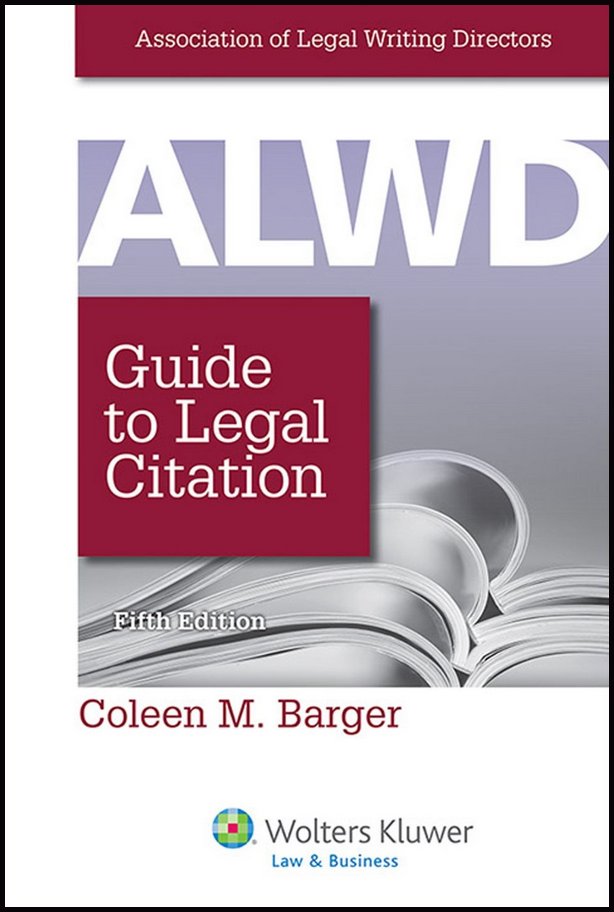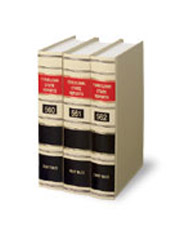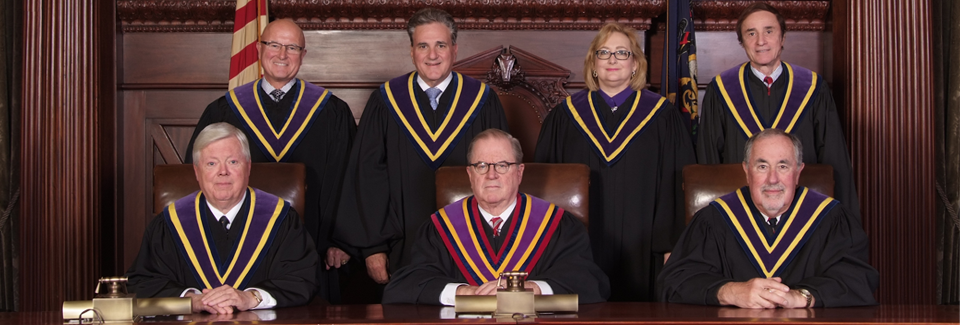
The fifth edition of the ALWD Citation Manual was published this past month, renamed the ALWD Guide to Legal Citation and stripped of the previous subtitle “A Professional System of Citation.” That event warrants attention here. This post is the first but probably not the last commenting on this latest version of what has been an important citation reference and teaching book. (In view of the name change I’ll refer to it hereafter as the ALWD guide rather than switching back and forth between “manual” and “guide.”)
The obvious place to begin is with the work’s final capitulation to The Bluebook. The publisher’s description highlights this edition’s elimination of “stylistic differences between the ALWD Manual and the Bluebook, to help combat the perception that students who learn citation with ALWD do not know how to ‘Bluebook.’”
1. Editions 1 through 4
When first introduced in 2000, the ALWD guide offered an alternative approach on numerous issues of style. Fundamentally it set forth a “single and consistent set of rules for all forms of legal writing.” It rejected The Bluebook’s “separate and inconsistent systems” for academic writing and professional writing in the form of memoranda and briefs. Its citation rules were derived, it said, from professional consensus. Finally, reflecting the reality that in the world of law practice rules and practices specific to a jurisdiction often trump academically proclaimed “uniform” rules, it included an appendix detailing “local citation rules or preferences.” The subtitle accurately reflected this professional perspective.
The original ALWD guide didn’t allow itself to be trapped by The Bluebook’s inconsistencies. When the citation practice in some jurisdictions or courts offered a less cumbersome format than The Bluebook prescribed, the 2000 ALWD guide felt free to embrace it. ALWD members and fans of its guide were not content with securing its adoption by legal writing faculty. They sought to persuade law journals to adopt its style. They lobbied courts whose rules mandated Bluebook compliance to accept ALWD style as an alternative. In both respects they realized some success, although, no doubt, less than they had hoped for.
ALWD’s second edition (2002) maintained this independent stance. By the third (2006) the hope of winning over a critical mass of law journals had been relinquished, and consistent typeface conventions disappeared. For the first time the guide offered instruction on where and how to use large and small capital letters when “working with a journal or publisher that requires you to use this convention.” It also yielded on the typeface to be applied to statutory titles (“ordinary” rather than the “italics” called for by editions 1 and 2). The fourth edition (2010) brought further erosion. From the beginning the ALWD table of case name abbreviations had eschewed contractions. In the fourth edition for every word The Bluebook abbreviated with a contraction, the ALWD guide now offered that contraction as an alternative, coupled with the advice that if the writer chose to use contractions they should be used “consistently throughout the paper.” But on any number of other points ALWD style remained distinct.
No longer. Those few journals that call for the citations in article submissions to be formatted in ALWD style and state rules of procedure (like those in Alabama and Idaho) that specify ALWD style as a Bluebook alternative have been rendered dead letter. Why the complete surrender? Pressure from the guide’s main market segment and constituency, law students and those who teach them. The preface to the fifth edition explains (without once naming The Bluebook): “Feedback from membership surveys pointed to the staying power of certain scholarly traditions in legal citation and urged that ALWD modify its rules to acknowledge those traditions.” In the fifth edition, the publication’s ambition appears reduced to doing a better job than The Bluebook of delivering Bluebook content.
2. Positions Surrendered
What are some of the points on which ALWD has given up its distinct, reasonable and professionally grounded position?
a. Appellate court abbreviations
A simple one concerns the abbreviation for a state’s intermediate appellate court to be used when the cite itself does not identify the court. For example, the writer wishes to cite a decision of the Florida Court of Appeals, the Minnesota Court of Appeals, or the Texas Court of Appeals using its volume and page number in the National Reporter System. Per The Bluebook that is done as follows: Szarzynski v. Szarzynski, 732 N.W.2d 285 (Minn. Ct. App. 2007). Before the fifth edition the ALWD work took the sensible position that “Ct.” was unnecessary and instructed that the citation be written: Szarzynski v. Szarzynski, 732 N.W.2d 285 (Minn. App. 2007). Several considerations commend that approach not the least of which is that Minnesota courts and lawyers employ that style. Jurisdictions that have implemented print-independent or neutral citation schemes along the lines recommended by the A.B.A. and the American Association of Law Libraries use the state abbreviation and “App” to designate decisions of intermediate appeals courts. Nor do they stand alone. In their citation practice any number of courts and lawyers employ the more economic “Fla. App.”, “Minn. App.”, and “Tex. App.” Sadly, the fifth edition of ALWD has abandoned that approach. Stripping unnecessary elements or characters from citations is always desirable.
b. Treatment of the Federal Appendix reporter
Another unfortunate point of Bluebook merger is on the abbreviation to be used in citations to that ridiculous reporter of “unreported” decisions, the Federal Appendix. The publisher’s abbreviation for this series is “Fed. Appx.” and that is how past editions of ALWD had it. Knowledgeable Bluebook users know that it favors “Fed. App’x”. A citation which The Bluebook would have be written, Robinson v. Allstate Ins. Co., 508 Fed. App’x 7 (2d Cir. 2013), ALWD and the publisher formatted as Robinson v. Allstate Ins. Co., 508 Fed. Appx. 7 (2d Cir. 2013). Although this is a point of style on which the federal courts are themselves divided, a search of recent federal decisions uncovers a preference for “Fed. Appx.” of over two-to-one. Appealing the matter all the way to the top, one discovers that the Supreme Court consistently employs “Fed. Appx.” There is no justification other than conformity for the ALWD guide to yield on this point.
c. Use of contractions in case names
The Bluebook’s use of “App’x” rather than “Appx.” reflects a general attachment to contractions. They dot its list of abbreviations to be used in case names – “Ass’n” for “Association”, Comm’r for Commissioner, Dep’t for Department, Eng’r for Engineer, Fed’n for Federation, Int’l for International, and so on. As noted above, prior to the fourth edition, the ALWD guide’s abbreviations contained no apostrophes; all ended with periods (e.g., Engr. and Intl.). The fourth edition authorized use of contractions as an alternative (e.g., Engr. or Eng’r, Intl. or Int’l). This new fifth edition specifies contractions wherever The Bluebook does without an alternative. Where The Bluebook takes an inconsistent approach (“Envtl.” rather than “Envt’l”) ALWD now follows. Such slavish conformity cannot be justified in terms of uniformity of professional practice, for in this area, most especially, citation norms vary enormously.
d. Internet materials
In its coverage of materials available on the Internet ALWD’s fourth edition called for the URL to be placed in parentheses and for the citation to conclude with a date. In order of preference that date was to be either one explicitly carried by the document itself, or the date the site indicated it was most recently updated (“last updated”), or the date the writer last accessed the material (“accessed”).
To adhere to The Bluebook’s style on these points ALWD’s fifth edition had to strip the parentheses, change “last updated” to “last modified” and “accessed” to “last visited.” The citation treatment of Web materials does continue to evolve, and all these changes can find support in current professional practice. On the other hand, ALWD’s prior style choices were thoroughly defensible, and the conversion of “last updated” to “last modified” can only be explained on grounds of Bluebook conformity. The U.S. Supreme has gone both ways on the matter, and, as on so many other citation details, it follows its own style, using the phrase “as visited” to describe the date it accessed a Web-based document.
e. Et al.
Other points on which the ALWD fifth edition bows to Bluebook style include the citation of:
3. Bottom Line
The removal of the ALWD work’s prior subtitle is telling. The guide no longer provides an independent compilation or codification of professional practice. In joining the legion of “how to cite according to The Bluebook” books and study aids it reinforces the erroneous impression that U.S. legal citation style is both uniform and static. That was not true in 2000 when the ALWD guide first appeared. It is even less true today as the transformation and proliferation of legal information sources continues to accelerate. New and knotty issues of citation policy call for serious attention and fresh approaches. It is truly unfortunate that ALWD has ceded all initiative to others.


